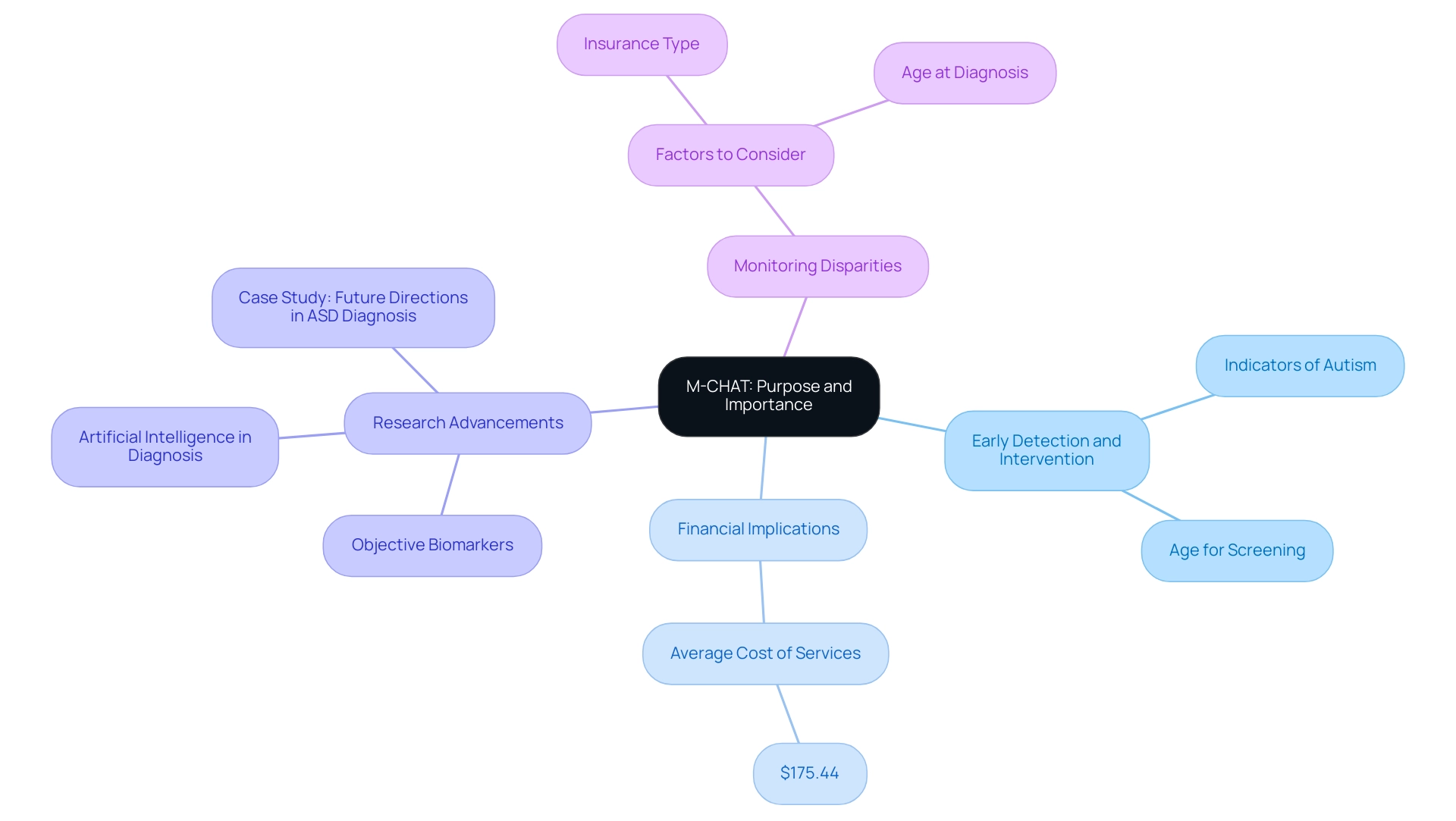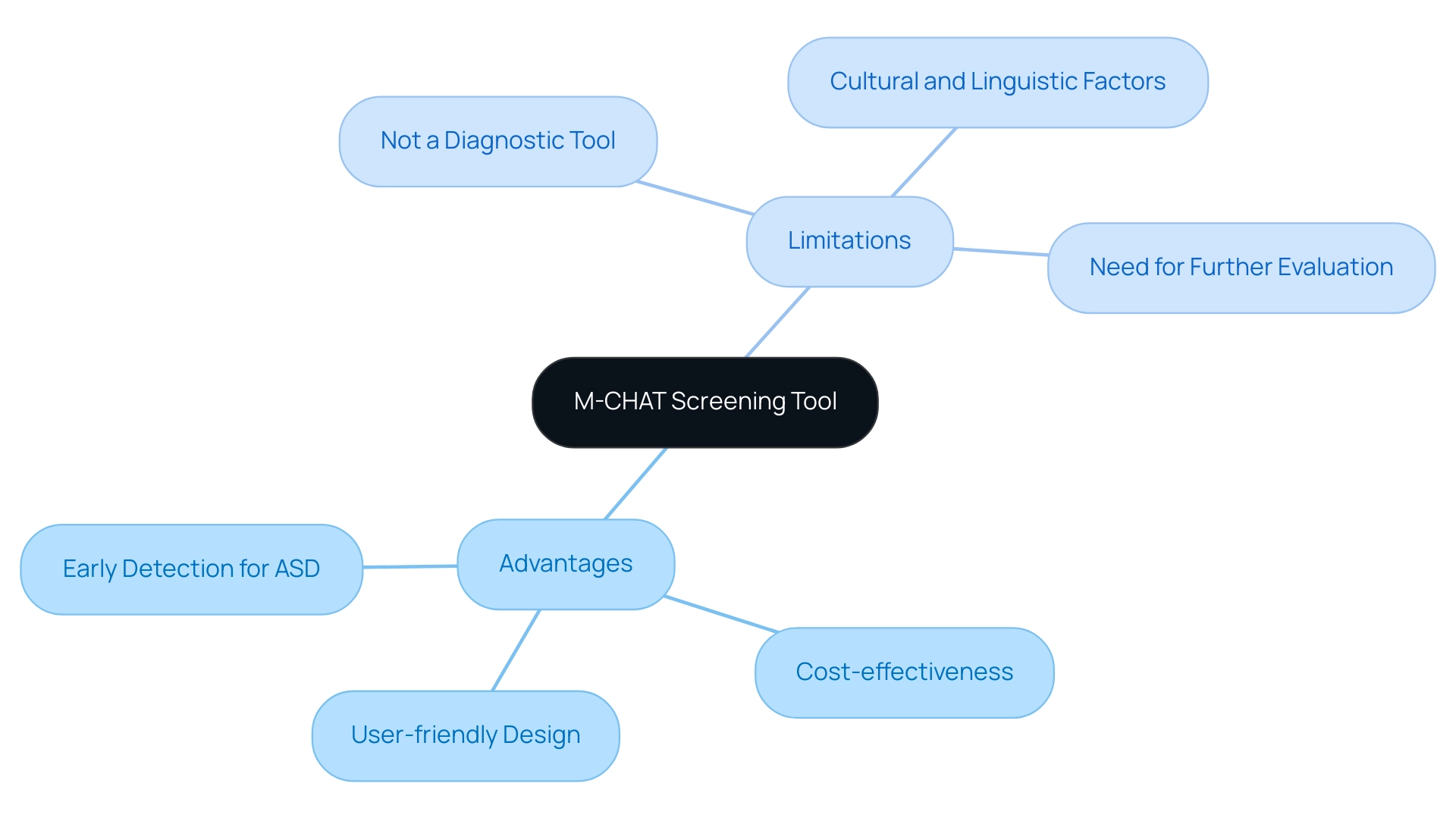Overview
The article titled "Understanding the M-CHAT: A Comprehensive Tutorial on Autism Screening" focuses on the significance and functionality of the Modified Checklist for Autism in Toddlers (M-CHAT) as a screening tool for early detection of autism spectrum disorder (ASD). It highlights that the M-CHAT facilitates early identification through a straightforward questionnaire, empowering parents to seek further evaluations and interventions, which are crucial for improving developmental outcomes for children at risk for ASD.
Introduction
Recognizing the signs of autism early can make a world of difference in a child's developmental journey. The Modified Checklist for Autism in Toddlers (M-CHAT) stands as a vital tool for parents seeking to identify potential risks associated with autism spectrum disorder (ASD). By facilitating early detection, the M-CHAT empowers families to take proactive steps toward securing necessary evaluations and interventions.
This article delves into the purpose and importance of the M-CHAT, its screening methodology, and how to interpret results, all while addressing the advantages and limitations of this essential screening tool. Understanding the significance of early autism screening not only aids in navigating the complexities of diagnosis but also fosters an environment where children can thrive and reach their fullest potential.
Introduction to the M-CHAT: Purpose and Importance
The Modified Checklist for Autism in Toddlers is a crucial screening instrument used to detect individuals who may be at risk for autism spectrum disorder (ASD). Its primary purpose is to facilitate early detection and intervention, which are pivotal for improving outcomes for individuals with m chat autism. By evaluating potential indicators of autism beginning at 18 months, this tool allows parents to pursue additional assessments and begin prompt interventions.
This proactive approach is vital, especially considering that, as noted by Chiugo Okoye from the California Institute of Behavioral Neurosciences & Psychology:
As it stands, there is no medication to treat ASD, hence no cure for it.
Early intervention can significantly enhance the quality of life for individuals with m chat autism by effectively addressing developmental challenges. Moreover, the average cost of therapeutic behavioral services is $175.44, highlighting the financial implications of autism interventions that families may face.
With advancements in research focusing on objective biomarkers and artificial intelligence for ASD diagnosis, as discussed in the case study titled 'Future Directions in ASD Diagnosis,' the accuracy and speed of identification are expected to improve. This ongoing research highlights the significance of the screening tool in pediatric practices, ensuring that families have access to the necessary support and resources as they navigate their offspring's developmental journey. Additionally, future research should monitor disparities in ASD diagnosis, considering factors such as insurance type and age at diagnosis, to provide a more comprehensive understanding of the challenges in autism screening.

How the M-CHAT Works: Screening Methodology
The M-CHAT autism, also known as the Modified Checklist for Autism in Toddlers, consists of 23 straightforward yes-or-no questions intended to assess a young person's behavior and developmental milestones. Parents typically fill out this questionnaire based on their observations of their offspring between the ages of 18 to 24 months. The scoring process is straightforward: responses indicating potential concerns categorize the individual as at risk for M-CHAT autism, prompting recommendations for further evaluation by a healthcare professional.
This user-friendly methodology empowers parents to engage actively in the evaluation process, making early detection accessible. Research highlights the essential importance of early assessment, demonstrating that prompt interventions can significantly enhance a young person's communication and social abilities, especially during the crucial stages of brain development. For instance, a case study titled 'Significance of Early Autism Screening' highlights how early intervention can enhance a child's developmental trajectory.
Dr. Fein emphasizes the importance of such screenings, stating, "These screenings offer a vital opportunity for early diagnosis, which can lead to effective intervention strategies." Furthermore, recent discoveries suggest that across 54 pediatric practices, no differences were identified in referrals to ASD specialists among various racial or ethnic groups, reinforcing the necessity and fairness of widespread implementation. Furthermore, the diagnostic odds ratio (DOR) for studies conducted in languages other than English is 361.76 (95% CI, 145.80-897.58), illustrating the methodology's robustness across diverse populations.
By encouraging parent involvement, this assessment acts as a crucial instrument in the early identification of M-CHAT autism, ultimately improving the chances for favorable results.
Interpreting M-CHAT Results: What They Mean for Families
The Modified Checklist for Autism in Toddlers results classify youths into three separate risk categories: low risk, medium risk, and high risk for autism spectrum disorder (ASD). A low-risk score typically suggests that the individual is developing on track, while medium and high-risk scores indicate the need for additional evaluation. Specifically, the screening tool has two cutoff scores for identifying screen-positive cases, requiring a child to screen positive on three items.
For families who receive medium or high-risk results, it is crucial to consult with healthcare professionals specializing in developmental disorders to explore further assessments and potential interventions. According to a recent meta-analysis, the positive predictive value (PPV) for identifying any developmental concerns using the screening tool scores is remarkably high at 57.7%, while the PPV for identifying ASD was calculated at 0.54 when using both the screening tool and follow-up assessments. This reflects the tool's effectiveness in signaling the need for follow-up.
Additionally, the negative predictive value (NPV) was found to be 99.7%, indicating a high reliability for screen-negative participants. As Victoria Lukashevich, a health study student at Utica College, emphasizes, it is possible that disparities in ASD assessment, prevalence, and intervention vary at different locations due to underlying factors. This insight underscores the necessity for families to understand that outcomes are not uniform and can differ based on various contexts.
By analyzing results accurately, families can make informed choices regarding their offspring's next steps, improving the route to suitable interventions and assistance when needed.
Advantages and Limitations of the M-CHAT Screening Tool
The assessment tool provides many advantages, especially its user-friendly design, cost-effectiveness, and its vital function in the early detection of youngsters at risk for autism spectrum disorder (ASD). Its accessibility empowers parents to engage proactively with their offspring's developmental health. However, it is essential to recognize its limitations.
Notably, this screening tool is not a diagnostic instrument; a positive screening result merely indicates the necessity for additional evaluation rather than a definitive diagnosis. Furthermore, cultural and linguistic factors can influence responses, potentially leading to misinterpretation of results. For instance, as emphasized in recent studies, the mean age of youngsters assessed across various studies was 23.3 months, which highlights the significance of context when interpreting scores.
Understanding both the advantages and the limitations of the M-CHAT equips families to utilize the tool effectively while advocating for comprehensive evaluations and tailored interventions for their offspring. Experts like Kathleen Campbell from Duke University emphasize the value of digital adaptations of the M-CHAT-R/F, stating,
'The digital version of the M-CHAT-R/F automatically scored answers and presented and scored follow-up questions for secondary evaluation of medium-risk results,'
which streamlines the scoring process and enhances follow-up assessments. Furthermore, upcoming studies should concentrate on the validation of the M-CHAT-R/F in high-risk groups, such as individuals with older siblings diagnosed with ASD, to refine the thresholds for risk classification.
As parents navigate these complexities, a balanced perspective enables them to utilize the M-CHAT as a stepping stone toward comprehensive evaluation and support, especially as early assessments can significantly influence diagnosis and treatment initiation for ASD.

The Significance of Early Autism Screening: Why Timing Matters
Early autism screening serves as a cornerstone for timely interventions, crucial for enhancing a young person's developmental trajectory. Research has shown that children receiving early support typically demonstrate improved communication skills, social capabilities, and overall developmental outcomes. For instance, a comprehensive assessment conducted before age three allows parents to access vital resources and therapies that may not be readily available at later stages.
Wiggins et al. noted that the M-CHAT autism exhibits higher sensitivity for ASD compared to general concerns assessed by other tools, underscoring its importance in early detection. Moreover, a recent study using the CSBS DP Infant/Toddler Checklist identified 56 out of 60 youths with ASD classified independently at the age of three years, providing concrete evidence of the effectiveness of early assessment tools.
Additionally, there is a growing interest in identifying biological measures for assessing ASD risk, as highlighted in the case study titled 'Biological Measures for ASD Risk Assessment.' This urgency in understanding the need for screening empowers parents to advocate effectively for their offspring's needs, ensuring access to appropriate support. As a result, families can create a nurturing environment that promotes optimal growth and development, laying a strong foundation for their children’s future.
Conclusion
Early detection of autism through tools like the Modified Checklist for Autism in Toddlers (M-CHAT) is a powerful step in supporting children's developmental needs. This article has highlighted the M-CHAT's vital role in identifying at-risk children and facilitating timely interventions that can significantly improve outcomes. By understanding its screening methodology, interpreting results effectively, and acknowledging both the advantages and limitations of the M-CHAT, parents can become empowered advocates for their children.
Recognizing the signs of autism early allows families to secure necessary evaluations and interventions, fostering an environment where children can thrive. The ability to categorize risk levels and seek further assessments based on M-CHAT results equips parents with the knowledge to make informed decisions about their child's developmental journey. As research continues to evolve, the importance of early screening remains paramount in ensuring access to resources that can enhance a child's communication, social skills, and overall well-being.
In conclusion, embracing the M-CHAT as a proactive tool in autism screening not only aids in timely diagnosis but also lays the groundwork for a supportive framework that enables children to reach their fullest potential. By prioritizing early detection and intervention, families can help shape a brighter future for their children, filled with opportunities for growth and development.
Frequently Asked Questions
What is the Modified Checklist for Autism in Toddlers (M-CHAT)?
The M-CHAT is a screening instrument designed to detect individuals who may be at risk for autism spectrum disorder (ASD), facilitating early detection and intervention.
At what age should the M-CHAT be administered?
The M-CHAT is typically filled out by parents for children between the ages of 18 to 24 months.
How does the M-CHAT work?
The M-CHAT consists of 23 yes-or-no questions assessing a young person's behavior and developmental milestones. Responses indicating potential concerns categorize the individual as at risk, prompting further evaluation by a healthcare professional.
Why is early detection of autism important?
Early detection allows for prompt interventions, which can significantly enhance a child's communication and social abilities during critical stages of brain development.
What are the financial implications of autism interventions?
The average cost of therapeutic behavioral services for autism interventions is approximately $175.44, which can pose financial challenges for families.
What advancements are being made in autism diagnosis?
Research is focusing on objective biomarkers and artificial intelligence to improve the accuracy and speed of ASD diagnosis, highlighting the ongoing importance of screening tools like the M-CHAT.
Are there disparities in ASD diagnosis?
Future research should monitor disparities in ASD diagnosis, including factors such as insurance type and age at diagnosis, to better understand challenges in autism screening.
How does the M-CHAT empower parents?
The M-CHAT encourages parent involvement in the evaluation process, making early detection more accessible and improving the chances for favorable outcomes for children at risk for autism.




